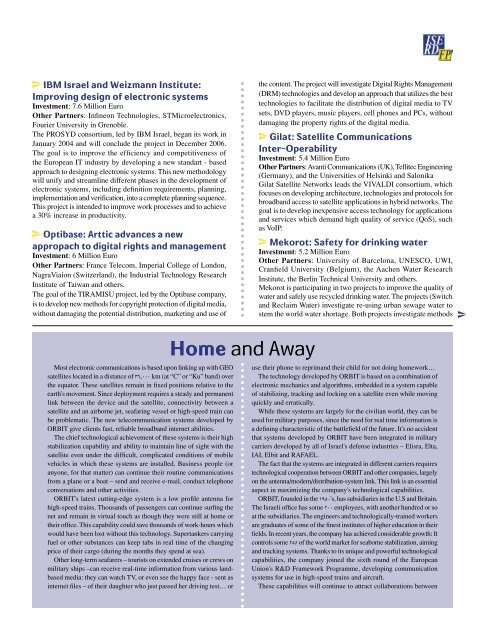Télécharger le document - Eurosfaire
Télécharger le document - Eurosfaire
Télécharger le document - Eurosfaire
Create successful ePaper yourself
Turn your PDF publications into a flip-book with our unique Google optimized e-Paper software.
IBM Israel and Weizmann Institute:<br />
Improving design of e<strong>le</strong>ctronic systems<br />
Investment: 7.6 Million Euro<br />
Other Partners: Infineon Technologies, STMicroe<strong>le</strong>ctronics,<br />
Fourier University in Grenob<strong>le</strong>.<br />
The PROSYD consortium, <strong>le</strong>d by IBM Israel, began its work in<br />
January 2004 and will conclude the project in December 2006.<br />
The goal is to improve the efficiency and competitiveness of<br />
the European IT industry by developing a new standart - based<br />
approach to designing e<strong>le</strong>ctronic systems. This new methodology<br />
will unify and streamline different phases in the development of<br />
e<strong>le</strong>ctronic systems, including definition requirements, planning,<br />
imp<strong>le</strong>mentation and verification, into a comp<strong>le</strong>te planning sequence.<br />
This project is intended to improve work processes and to achieve<br />
a 30% increase in productivity.<br />
Optibase: Arttic advances a new<br />
appropach to digital rights and management<br />
Investment: 6 Million Euro<br />
Other Partners: France Te<strong>le</strong>com, Imperial Col<strong>le</strong>ge of London,<br />
NagraViaion (Switzerland), the Industrial Technology Research<br />
Institute of Taiwan and others.<br />
The goal of the TIRAMISU project, <strong>le</strong>d by the Optibase company,<br />
is to develop new methods for copyright protection of digital media,<br />
without damaging the potential distribution, marketing and use of<br />
Most e<strong>le</strong>ctronic communications is based upon linking up with GEO<br />
satellites located in a distance of 36,000 km (at “C” or “Ku” band) over<br />
the equator. These satellites remain in fixed positions relative to the<br />
earth's movement. Since deployment requires a steady and permanent<br />
link between the device and the satellite, connectivity between a<br />
satellite and an airborne jet, seafaring vessel or high-speed train can<br />
be prob<strong>le</strong>matic. The new te<strong>le</strong>communication systems developed by<br />
ORBIT give clients fast, reliab<strong>le</strong> broadband internet abilities.<br />
The chief technological achievement of these systems is their high<br />
stabilization capability and ability to maintain line of sight with the<br />
satellite even under the difficult, complicated conditions of mobi<strong>le</strong><br />
vehic<strong>le</strong>s in which these systems are instal<strong>le</strong>d. Business peop<strong>le</strong> (or<br />
anyone, for that matter) can continue their routine communications<br />
from a plane or a boat – send and receive e-mail, conduct te<strong>le</strong>phone<br />
conversations and other activities.<br />
ORBIT's latest cutting-edge system is a low profi<strong>le</strong> antenna for<br />
high-speed trains. Thousands of passengers can continue surfing the<br />
net and remain in virtual touch as though they were still at home or<br />
their office. This capability could save thousands of work-hours which<br />
would have been lost without this technology. Supertankers carrying<br />
fuel or other substances can keep tabs in real time of the changing<br />
price of their cargo (during the months they spend at sea).<br />
Other long-term seafarers – tourists on extended cruises or crews on<br />
military ships –can receive real-time information from various landbased<br />
media: they can watch TV, or even see the happy face - sent as<br />
internet fi<strong>le</strong>s – of their daughter who just passed her driving test… or<br />
Home and Away<br />
the content. The project will investigate Digital Rights Management<br />
(DRM) technologies and develop an approach that utilizes the best<br />
technologies to facilitate the distribution of digital media to TV<br />
sets, DVD players, music players, cell phones and PCs, without<br />
damaging the property rights of the digital media.<br />
Gilat: Satellite Communications<br />
Inter-Operability<br />
Investment: 5.4 Million Euro<br />
Other Partners: Avanti Communications (UK), Tellitec Engineering<br />
(Germany), and the Universities of Helsinki and Salonika<br />
Gilat Satellite Networks <strong>le</strong>ads the VIVALDI consortium, which<br />
focuses on developing architecture, technologies and protocols for<br />
broadband access to satellite applications in hybrid networks. The<br />
goal is to develop inexpensive access technology for applications<br />
and services which demand high quality of service (QoS), such<br />
as VoIP.<br />
Mekorot: Safety for drinking water<br />
Investment: 5.2 Million Euro<br />
Other Partners: University of Barcelona, UNESCO, UWI,<br />
Cranfield University (Belgium), the Aachen Water Research<br />
Institute, the Berlin Technical University and others.<br />
Mekorot is participating in two projects to improve the quality of<br />
water and safely use recyc<strong>le</strong>d drinking water. The projects (Switch<br />
and Reclaim Water) investigate re-using urban sewage water to<br />
stem the world water shortage. Both projects investigate methods<br />
use their phone to reprimand their child for not doing homework…<br />
The technology developed by ORBIT is based on a combination of<br />
e<strong>le</strong>ctronic mechanics and algorithms, embedded in a system capab<strong>le</strong><br />
of stabilizing, tracking and locking on a satellite even whi<strong>le</strong> moving<br />
quickly and erratically.<br />
Whi<strong>le</strong> these systems are largely for the civilian world, they can be<br />
used for military purposes, since the need for real time information is<br />
a defining characteristic of the batt<strong>le</strong>field of the future. It's no accident<br />
that systems developed by ORBIT have been integrated in military<br />
carriers developed by all of Israel's defense industries – Elisra, Elta,<br />
IAI, Elbit and RAFAEL.<br />
The fact that the systems are integrated in different carriers requires<br />
technological cooperation between ORBIT and other companies, largely<br />
on the antenna/modem/distribution-system link. This link is an essential<br />
aspect in maximizing the company's technological capabilities.<br />
ORBIT, founded in the 1950's, has subsidiaries in the U.S and Britain.<br />
The Israeli office has some 200 employees, with another hundred or so<br />
at the subsidiaries. The engineers and technologically-trained workers<br />
are graduates of some of the finest institutes of higher education in their<br />
fields. In recent years, the company has achieved considerab<strong>le</strong> growth: It<br />
controls some 25% of the world market for seaborne stabilization, aiming<br />
and tracking systems. Thanks to its unique and powerful technological<br />
capabilities, the company joined the sixth round of the European<br />
Union's R&D Framework Programme, developing communication<br />
systems for use in high-speed trains and aircraft.<br />
These capabilities will continue to attract collaborations between

















